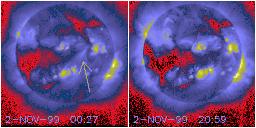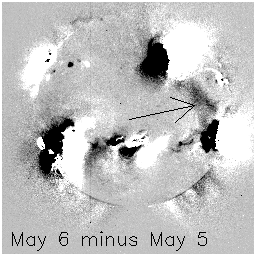
If you've read the latest Nugget in the set above, you know that the reason we like TILs is that the mere fact that they straddle the solar equator implies that the mysterious and wonderful phenomenon of magnetic reconnection has to have occurred. These structures are nice and large, well-resolved by the Yohkoh SXT optics, and tend to be more visible in these X-ray images than in the EUV images of other space missions such as TRACE or SOHO.
Here we discuss the gradual disappearance of one of the TIL indicated below:

The arrow shows the disappearing TIL, and the times span two consecutive days of Yohkoh real-time telemetry data. When we saw this, we loudly quoth AHA!, thinking that we were seeing a CME in the process of formation. That was because of...
In May 1998, Yohkoh spotted a remarkable set of sudden TIL disappearances (we might call these DILs, for "disappearing interconnecting loops; or maybe TILDEs, for "trans-equatorial interconnecting loop disappearing events"). Any casual bystander can see why we like these acronyms!
The difference image below shows the TILDE of May 6, 1998:

The arrow marks the disappearing TIL. This event was caused by a huge flare at its south end, and remarkably enough the TIL re-formed the next day, and the next, and two more flares happened. Each produced a TILDE! Khan and Hudson have described these events, which led to coronal mass ejections, in a paper for Geophysics Research Letters - we'll add a link when it is in final form.
This week's DIL turned out not to have been flare-associated, and no CME happened either. Disappointing, but perhaps this just means that these structures behave analogously to filaments, which can disappear promptly (disparitions brusque (DB)) or more gradually. DBs may be of two types, thermal (due principally to temperature changes) or dynamically (due to ejection). This distinction might essentially reflect non-thermal and thermal processes. Perhaps similar types of phenomena can occur with TILs? The movie below shows the slow disappearance in this week's case. It's not very satisfactory but science nuggets are invariably done in haste! The movie (raw data) shows you the TIL dissapearance along with lots of other things, including a CME-related arcade event in the NE polar region. Take our word for it, the TIL itself is beautiful (see the still figure for November 2 above), even if its disappearance is humdrum.

So from the physics point of view, it seems like the disappearance of this week's DIL had more to do with a reduction of gas pressure (cooling), reducing its visibility in the soft X-ray images (which see hot things well). A test of this idea, for somebody with a bit more time, would be to look at SOHO EIT data and see if the DIL was still a TIL on November 3!
November 5, 1999
Hugh Hudson (hudson@isass1.solar.isas.ac.jp)
Joe Khan (khan@isasxa.solar.isas.ac.jp).